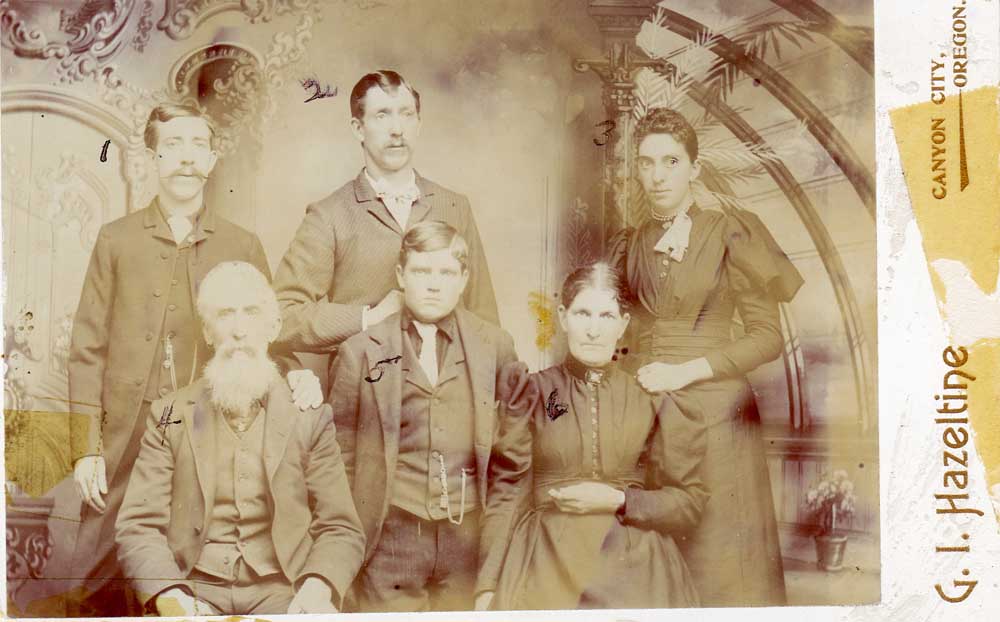George I. Hazeltine: A lasting legacy in pictures and Kam Wah Chung
Published 1:15 pm Tuesday, September 26, 2023

- This brown tone photo shows the Otis Guernsey family. In the back row, left to right, are Chester G. Guernsey, Hosea Guernsey and Lena Guernsey, who later married William Lincoln on February 25, 1892. In the front row, right to left, are Otis Guernsey, Charles Guernsey, who was adopted, and Nancy Guernsey.
One of the most important pioneers of 19th century Oregon and Grant County is George I. Hazeltine, who became an important civic leader, in addition to a renowned miner, the first to open a flour mill east of the Cascades and, according to the state park curator, the man behind the building of Kam Wah Chung.
But we also have a window into the artistry of the man with his legacy as a photographer and the images he left behind for future generations from his work as a Canyon City-based photographer throughout the late 19th and early 20th century.
Hazeltine was born on May 4, 1836, in Cattaraugus County, New York, but spent most of his early life in St. Charles, Illinois, according to “The Centennial History of Oregon, 1811-1912,” which was published in 1912, when Hazeltine was still alive at the age of 76.
According to information archived by the Orbis Cascade Alliance, a nonprofit library consortium serving 38 colleges and universities in Oregon, Washington and Idaho, Hazeltine trained as a photographer in New York City in 1852. He and his brother Martin operated a daguerreotype studio in San Francisco from 1853 to 1855, according to a biographical sketch of Hazeltine on the nonprofit’s website.
Hazeltine divided his attention among photography, various mining and business enterprises and public service, according to the Orbis Cascade Alliance.
He first opened his own photography business in Coloma, in Northern California, having been drawn to mining for gold near Sutter’s Mill, the site of the California gold rush of the mid-19th century, according to “The Centennial History of Oregon, 1811-1912.”
He began mining a claim in Canyon City in 1862 and established a pack train service from Canyon City to The Dalles in 1864, according to the Orbis Cascade Alliance. Hazeltine also served as Grant County judge from 1878 to 1882 and again from 1890 to 1894, as well as county treasurer from 1896 to 1898.
As a photographer, Hazeltine concentrated on studio portraiture and scenic views of Eastern Oregon and briefly rejoined his brother Martin in operating a studio at Baker City but soon returned to Canyon City, according to the Orbis Cascade Alliance.
In early March of this year, Kam Wah Chung museum curator Don Merritt came across information from the Grant County Historical Museum about Hazeltine’s acquisition of a homestead in John Day. Merritt also discovered, through online general land office maps from the Bureau of Land Management, that the property was owned by George Hazeltine in 1871.
“So my thinking is, if he owned a freight business on the Canyon City-to-Dalles wagon road, he probably built this building for his freight business that he ran for, like, one or two years, purchased the property and then, sometime in 1871, leased it to the Chinese to open Kam Wah Chung and Co.,” Merritt told the Blue Mountain Eagle. “We know it was established in 1871 — we have all kinds of evidence of that.”
Loosely translated as the “Golden Flower of Prosperity,” Kam Wah Chung was the longtime location of a successful commercial venture for two Chinese immigrants, herbal doctor Ing “Doc” Hay and businessman Lung On. It also served as a social and religious center for the Chinese community over 60 years. It is now a popular tourist attraction and cultural resource in John Day.
Hazeltine owned the Kam Wah Chung property until 1874, Merritt said.
“Someone else bought the property at that point,” he said. “We know a woman owned the property in 1885, shortly before Doc Hay and Lung On purchased it in 1888.”
Merritt said Hazeltine also built a courthouse in Canyon City in the 1880s, and the stonework in that building and Kam Wah Chung was identical. (The structure predates the current Grant County Courthouse, which was built in 1952.)
Merritt said evidence points to Chinese laborers having worked on the cornering of the rocks and the stonework on the Kam Wah Chung building.
Invaluable assistance in the preparation of this special section was provided by the Grant County Historical Museum. Curator Kitman Kienzle supplied the Eagle with historical photographs, newspaper articles and other source material from the museum’s collections.




